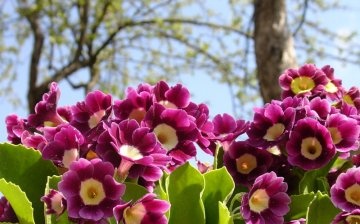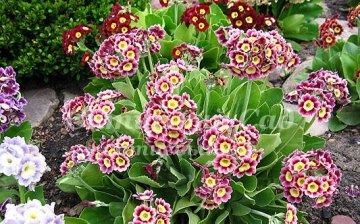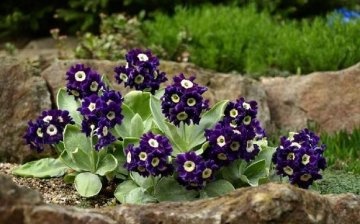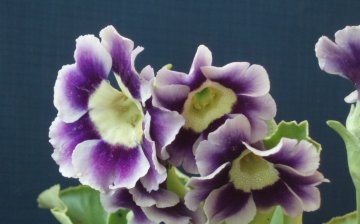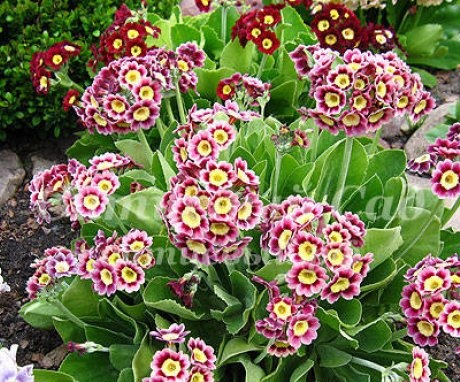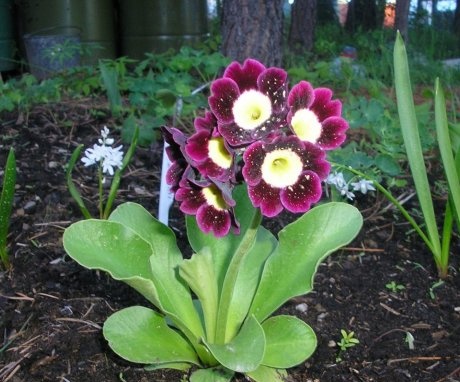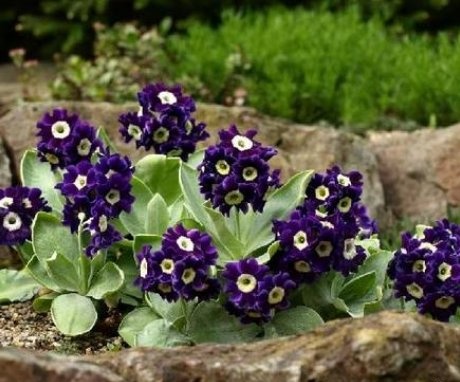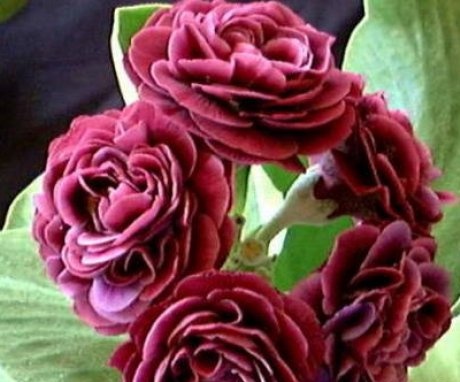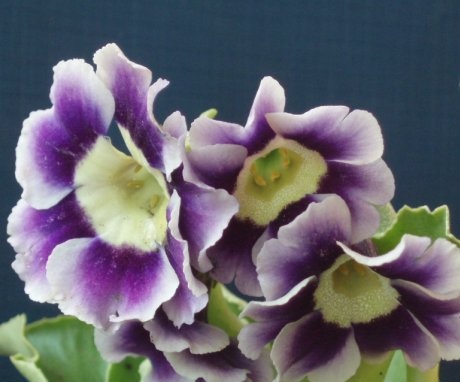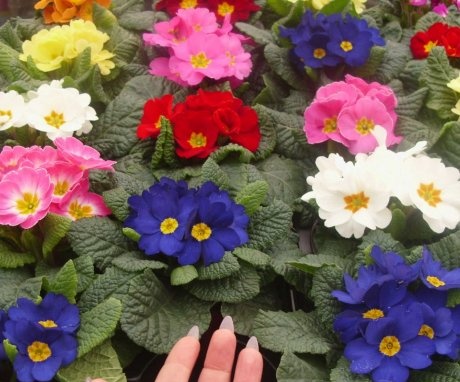Primula ear - a colorful symbol of spring
After a dull winter, I want to see the first flowers as soon as possible, which will return the lost colors to the garden. During this period, all attention is focused on primroses - charming crumbs that begin to sparkle brightly on the still bare ground.
Content:
- Ear primrose: the beginning of a close acquaintance
- How to propagate primrose seeds
- Other ways to grow primroses
- What conditions do primroses like?
- What is Auricula afraid of?
- Primroses as an element of decor
Ear primrose: the beginning of a close acquaintance
Love for primroses has become the source of many legends. One of them tells how the dozing apostle Peter dropped the keys to Paradise. Having touched the ground, they sprouted with colorful flowers - primroses. Since then they have been called "keys". The inhabitants of Foggy Albion believe that gnomes and fairies live in primroses. When it rains, they decorate their homes with water drops.
The genus name Primula is translated from Latin as "first" or "early".
Comprises more than 550 species... To complete the picture, all varieties bred by breeders must be added to this figure. To somehow organize such a fantastic abundance, gardeners have divided the flowers into 23 sections. Primroses are found all over the world. Some species cannot be grown in a flower garden, since the natural conditions for their growth are quite specific. Approximately 200 varieties are cultivated without much difficulty.
A favorite of gardeners - primrose auricular or auricula. The birthplace of perennials is the Alps and the Apennines. They manage to grow on rocky soil, calcareous slopes and rocks.
Color features:
- The wrinkled leaves are large, oblong-oval, with small teeth.
- The underside is slightly mealy. Their height reaches 15 cm.
- The palette of auricles is quite diverse.
- An attractive umbrella of 30 small flowers rises above the leaves from April to May.
- The peculiarity of the plant is bright eyes, juicy color of petals.
- Peduncles arise in autumn, develop under snow cover. This is the secret of the early splash of colors.
- In autumn, fruit pods are formed. Small balls of dark seeds are inside.
Primroses are unpretentious and durableare not afraid of the cold. The plant retains its attractiveness from early spring to late autumn. In spring, primroses are among the first to bloom on flower beds, delighting the eye with a bright palette after a monochromatic winter.
How to propagate primrose seeds
It takes patience to be successful. When stored in winter, planting material quickly loses its quality. It takes quite a long time to grow. The best option is sow freshly harvested seeds into open soil or prepared boxes.
Work can be carried out in late autumn before the onset of frost. It is important that the primroses do not have time to germinate.
In spring, primroses are sown after stratification, which is a prolonged exposure to cold. It is even better to apply temperature buildup, alternately influencing the material with heat and cold. To do this, many times throughout the day, the seeds are moved from the refrigerator to the room and vice versa.
If flowers will sprout on a windowsill or in a greenhouse, then you need to wait until early February.The substrate is prepared by mixing 2 parts of leaf humus, 1 part of sod land and the same amount of sand.
Sequencing:
- Sow seeds to the surface, sprinkled with the thinnest layer of earth.
- Cover with foil.
- Place in a warm place for a few days to swell the seeds.
- Keep in the cold for 3-4 weeks (in the refrigerator or on an unheated balcony). During this period, it is necessary to monitor soil moisture and the awakening of crops.
- After emergence, place the container on the window. The suitable temperature regime is 180C. If a month in the cold has passed unchanged, it's still time to expose the material to heat.
- Remove the film, but protect the primroses from direct sunlight. Make sure that the soil does not dry out.
- After the appearance of 1-2 true leaves, dive the seedlings. Plant her in boxes or in a previously prepared place.
- When picking between seedlings, maintain a distance of 20 cm. In the second year of vegetation, primroses are allocated a permanent place. After 2-3 years, they will delight you with flowers.
Reproduction primrose abalone seeds is a rather troublesome and lengthy process.
Other ways to grow primroses
Plants that are 3-4 years old are old enough. They grow strongly, they no longer bloom so profusely, become more sensitive to frost. The optimal time for work is early spring, from August to early September. Primroses can be transplanted immediately after flowering and, if necessary, during flowering.
First, the plants are watered abundantly. The rhizome of the dug out auricle is divided into parts with a knife so that each has at least one renewal bud. Slices are immediately sprinkled with ash. It is better to plant the rags right awayuntil they are dry. The distance between plants is from 10 to 30 cm.
New primroses need daily watering for 10-15 days.
Cutting:
- Rosettes of leaves are cut from May to June.
- They are planted in cold greenhouses or directly in the beds.
- After 15-20 days, primroses take root.
- Cuttings overwinter right there. With the onset of spring, they are transplanted to a permanent place.
Bush division and cuttings are quite simple and affordable methods of reproduction of primroses.
What conditions do primroses like?
Spring queens love teens. In summer, in an open space, the flower will disappear. The ideal condition is diffused sunlight through the foliage of the trees. To be successful in growing auriculi, it is important to monitor the condition of the soil. In their natural environment, they grow in places with high humidity.
Primroses should not feel a lack of water, but excessive dampness will also not be beneficial.
Auricular primrose comes from the highlands, where in the spring it simply bathes in melt water. In mid-latitudes, dry, sunny April and May days are dangerous for flowers.
They will weaken and wither if at this time of intensive growth they feel a lack of moisture. Exactly in the spring it is important to keep track ofso that the soil does not dry out.
Auriculums are not suitable for soil, which contains a lot of clay. In such flower beds, the situation can be corrected by adding:
- Sand (1 bucket per 1 m2).
- Vermiculite.
- Cut sphagnum moss.
- Organic fertilizers (20 kg per 1 m2).
- A new topsoil prepared from a nutrient mixture (20 cm).
Mineral fertilizers are added 2-3 years after planting. Phosphorus and potassium substances are introduced in the fall. Organic fertilizers are essential for depleted soil. They saturate it with nutrients, affect the structure. Decomposed humus, leafy soil, weathered peat are used.
Supplements of phosphorus and potassium provide the pomp of the primrose umbrellas.
The root system, as it develops, rises above the ground. The roots that are near the surface are exposed. Every autumn, soil is poured under the primroses to cover them.
The soil is periodically loosened and weeds weed. So that the auricula can withstand the winter cold well, recommend keeping the outlet until late autumn. The leaves provide a natural shelter from the cold. Cultivation of ear primrose will not cause any particular difficulties if you learn everything you need to know about proper care for it.
What is Auricula afraid of?
Primroses are quite hardy plants. However, they are threatened by:
- Downy mildew.
- Gray rot.
- Ramulariasis.
- Slugs.
- Root aphid.
- Spider mite.
- Fleas.
- Rust.
- Bacterial leaf spot.
In conditions of high humidity at moderate temperatures, the upper part of the leaves is covered with yellowish spots, and the lower part is covered with a whitish bloom. This is how downy mildew manifests itself. Disease can be prevented by systematic weed control. It is better to remove heavily affected primroses from the flower bed altogether.
The gray fluffy bloom of fungal sporulation throughout the flower will tell about the attack of gray rot. The disease develops when nitrogen concentration in the soil is high, in cold and damp weather. Ants make a significant contribution to the spread of the pest. In preventive measures, it is worth not allowing a large accumulation of insects in the flower bed. "Anteater" will help in the fight.
In both cases, Bordeaux mixture, copper oxychloride will help save the plant. During processing, damaged leaves are removed. They also treat ramulariasis, which is manifested by oval spots, first yellow, and later brown.
Slugs attack the plant in high humidity conditions.
The probability of damage to root aphids increases, when primroses grow in a very dry place or in pots. If the primrose is not given attention, the infected leaves will dry out, the flowers will lose their splendor. For preventive purposes, in early spring, auricles are treated with special fluids. In autumn, after flowering, the plant is sprayed with nitrafen (1%). Competent and timely help will help primroses get rid of pests and return to their former beauty.
Primroses as an element of decor
In early spring, auricles will brighten areas near trees and shrubs. Landscape designers decorate flower beds of all types and sizes, combining primroses with other plants.
Suitable neighbors for primroses in garden compositions:
Low-growing varieties are planted in groups as tightly as possible in order to hide the soil behind the flowers. Ear primrose is a great option for placing on stones. She will decorate an alpine slide or rockery.
The flowering time for the keys is different, depending on the type of plant. It becomes possible to create zones of continuous flowering by choosing the right types of plants. There are primroses that re-throw colorful umbrellas. This is an original decoration for the foreground of an autumn flower bed.
Ear primroses grow well in pots and pots... With their help, they create potted gardens, decorate balconies, terraces and window sills. Auricula will perfectly fit into the overall picture near water bodies.
Combining different varieties of primroses, they create an original garden interior.
Anyone who has planted at least one primrose bush on the site will no longer be able to forget about them. Love for auricles is forever.
More information can be found in the video.



